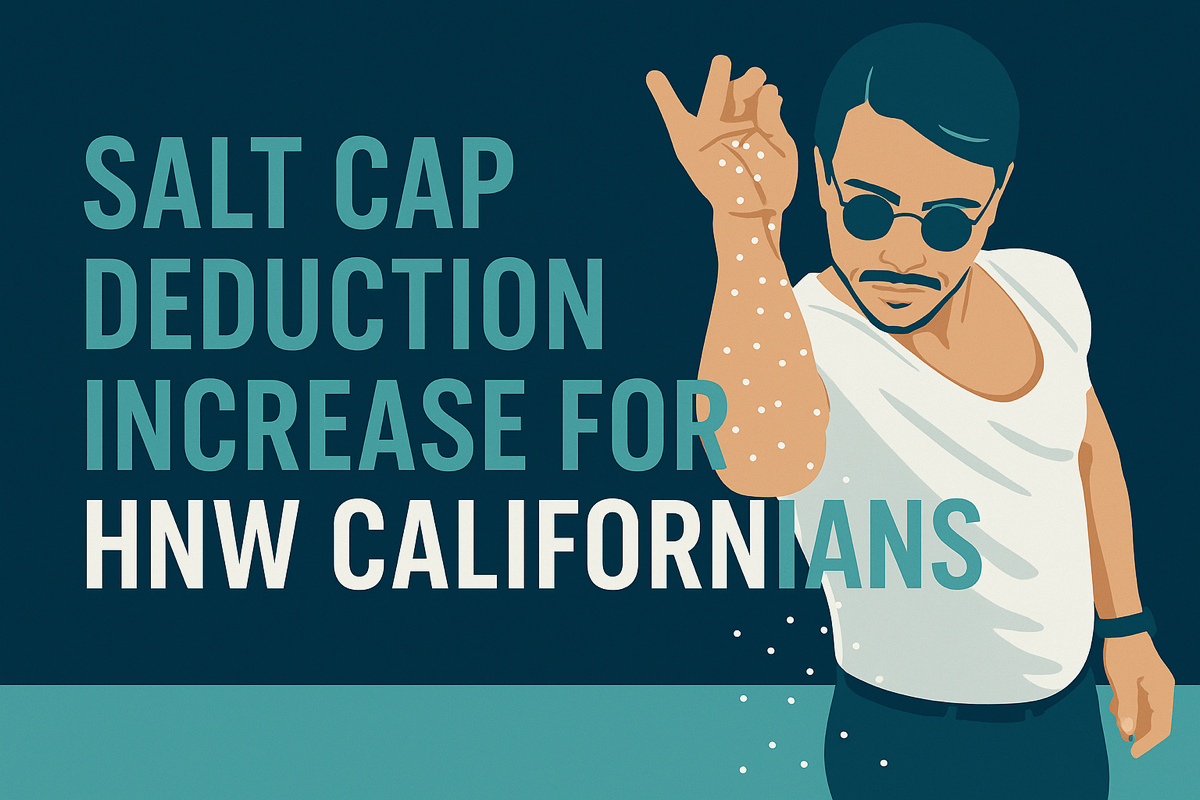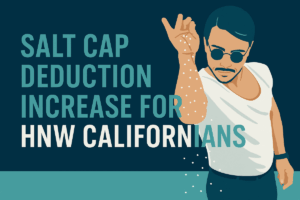California is long known for its high property taxes, income taxes, and overall cost of living — and those of us with substantial income and assets feel those impacts more keenly. The change in the SALT deduction cap (state and local tax deduction) under the recent tax law (the “One Big Beautiful Bill Act” or OBBBA) is one of the most consequential tax developments for high-tax states like ours. Understanding its mechanics, limitations, and planning implications can yield meaningful tax savings (or at least reduce surprises). Below is a deep dive.
Background: What Was the SALT Cap, What’s New
-
Under the 2017 Tax Cuts and Jobs Act (TCJA), the federal deduction for state and local taxes (SALT) that could be claimed by individuals was capped at $10,000 per year. That’s inclusive of state income taxes, local taxes, and property (or sales, where applicable).
-
Many Californians with high incomes and/or valuable real estate found themselves hitting that cap by a wide margin, meaning they were unable to deduct much of what they pay in state income tax, property tax, or other local taxes beyond $10K.
-
The OBBBA (One Big Beautiful Bill Act), effective 2025 through 2029 under current law, raises that cap to $40,000 for households with Modified Adjusted Gross Income (MAGI) of up to about $500,000. For those whose MAGI is above that threshold, the $40,000 cap phases down, eventually reverting to the old $10,000 cap for the highest earners.
-
Also, the new cap and thresholds are indexed annually (1% per year in many versions) for inflation/tax code adjustments through about 2029. After that, under certain proposals, the law reverts to stricter limits.
Who Benefits Most — and Who’s Left Out
For HNW Californians, this change is both welcome and laden with caveats.
Likely Beneficiaries
-
Upper-Middle‐Income Households in High Tax Areas
If your household income is under (or near) the phase-out threshold (~$500,000 MAGI), and you are paying well in excess of $10,000 in state income, property (and local) taxes, this change can give you a much larger deduction. That reduces your federal taxable income, helping reduce your overall tax liability.
-
Homeowners with Substantial Property Taxes + High State Income Taxes
In California, property taxes can be high, and for those in expensive counties or owning expensive homes, just property plus state income tax often exceeds $10,000 easily—even without counting sales or other local levies. Raising the cap to $40,000 gives far more room to deduct those taxes.
-
Those Who Previously Prorated Filings or Used Workarounds
Many HNW folks have already used strategies like pass-through entity taxes (PTEs) or state-level entity-based workarounds, to shift tax burdens off the individual so that state income taxes can be deducted at the entity level (which aren’t subject to the same SALT cap when properly structured). Some of those workarounds may yield less of a return versus simply leveraging the higher individual SALT cap.
Those Who May Not Benefit Much (or at All)
-
Very High Earners Above the Phase-down Threshold
If your MAGI significantly exceeds the $500,000 threshold, the benefit is reduced (“phased down”) and may revert to just $10,000 for those well above the limit. The marginal benefit for those in the top incomes will thus remain constrained.
-
People Who Don’t Itemize
The SALT deduction is only usable if you itemize. Many taxpayers (even HNW depending on other deductions) might find that the standard deduction is better, especially if other deductions are limited (e.g., due to AMT, etc.). If your itemizable deductions aren’t large beyond SALT + mortgage interest + other deductible expenses, the uplift may be muted.
-
Temporary Nature / Reversion Risk
These changes are not necessarily permanent in all versions; some versions revert caps back after a few years, or phase-downs tighten. Planning as if this is permanent could backfire.
Specific Impacts for HNW Californians
Here are particular implications for households in California with high net worth or high taxation burdens.
|
Situation |
Old SALT Regime |
New Regime Advantages |
Things to Watch / Risks |
|---|---|---|---|
|
High value property owners (Bay Area, coastal counties, etc.) paying high property taxes + state income taxes |
Deduction often capped at $10K, leaving much of property tax & state income tax un-deductible at the federal level |
Can now deduct up to $40K (if under income threshold), giving substantial federal tax savings; improves return on owning property; reduces effective tax burden |
Must carefully aggregate all SALT components; property tax bills, income tax, local taxes. Also ensure itemization makes sense. Revisit any property acquisitions or improvements under the new regime. |
|
Residents with high state income tax obligations |
Previously little relief federally beyond $10K; now more of the state income tax burden becomes deductible, reducing marginal tax rate slightly (especially high brackets) |
More predictable deductions, potentially avoid restructuring state income tax payments / estimated payments simply to manage SALT hit; better annual tax return performance; also less pressure to shift income across years purely for SALT reasons |
If income is volatile, could risk pushing over threshold; phase-downs might catch some in the middle unawares. Also, state tax policy still matters (if CA changes property tax rules or local assessment, etc). |
|
Owners of pass-through entities / business income taxed at personal level |
Many used the PTE workaround or similar entity-level payments to mitigate SALT cap; but complexity, cost, regulatory risk, and sometimes uncertain benefits |
With $40K cap, the margin benefit of a workaround is lower (for those under the income ceiling). Could simplify structuring; reduce cost of workarounds. |
Workarounds may still make sense if income from PTEs is significant and entity-level planning yields benefit. Be alert to IRS/CA guidance and possible audits. Also, if law changes, walk-back risk. |
|
Wealth transfer / estate planning / trust income |
Trust income is taxed at trust levels; some trusts may have paid SALT? But trusts often run into high bracket rates, may have limited deduction flexibility |
The increased cap means trust-level income (if trusts meet requirements and do not exceed thresholds) might be able to use more SALT; possibly enhance trust beneficiary distribution strategies; opportunities in splitting income among trusts so each doesn’t exceed thresholds. |
Complexity in trust design; setting up non-grantor trusts, tracking AGI per trust, beneficiary income; taxation rules (trustes have compressed brackets); administrative costs. Be cautious with IRS scrutiny. |
Planning Strategies Moving Forward
If you’re in my client cohort in California with HNW status, here are some potential tactical strategies to consider in light of the SALT cap increase.
-
Income Smoothing / Timing
If income in a given year will push you just above the phase-down threshold, you might accelerate or defer certain items: realize income in “lower” years, defer state taxable income, or adjust bonus / deferred comp timing. Especially in years where you expect your MAGI to be just above or below $500,000.
-
Leveraging Workarounds (PTEs, Entity-Level Taxes)
Even with a higher SALT cap, PTE workarounds may remain valuable depending on your business structure. Comparing the benefit of paying state/local taxes at the entity level vs. personal level remains on the table.
-
Trust Structuring
Using non-grantor trusts (or trusts with taxable status) to hold income producing assets, such that income is spread among multiple entities each staying under AGI thresholds to maximize SALT deductions. But again, any trust strategy must balance administrative costs, trustee/beneficiary dynamics, potential state-level trust tax, and legal compliance. (Plus, trusts hit high bracket rates fast.)
-
Examining Real Estate Acquisition/Improvements
For those considering new property investment or home upgrades that impact property tax, timing these events relative to tax year end may shift SALT exposure. For example, prepaying property tax (if possible), or timing deductible improvements.
-
Reviewing State Tax Payments & Estimates
Because the larger deduction depends in part on the total state and local taxes paid, planning the timing of estimated payments, considering paying in arrears vs advance, may provide flexibility if you’re near thresholds.
-
Itemization vs Standard Deduction Comparison
With the standard deduction still being large (post-TCJA), you need to run the numbers each year to see whether itemizing (including with the new SALT cap) provides more benefit. In some years with fewer deductible expenses beyond SALT, standard deduction plus other credits might still win.
-
Scenario Modeling for Various Future Outcomes
Given that some versions of the law may revert or change, it is prudent to model scenarios: one where SALT cap remains elevated, one where it phases down sooner, one with incremental tax rates changing, etc. Incorporate into long-term financial planning, cash flow, taxation of investment income, estate planning.
Big Picture: Impacts & Risks
-
State revenue & policy pressure: California (and other high-tax states) lose some leverage in “SALT cap politics” but will likely still push state/local taxes high because they fund services. The federal change reduces some of the federal penalty for those policies.
-
Behavioral & migration effects: Previous SALT limits were one factor pushing people (especially high income) to relocate to lower tax states. While the new cap softens that penalty for some, those making well above the phase-down thresholds might still feel the old pressures.
-
Fairness & public perception / political risk: Critics argue that raising the SALT cap primarily benefits those with high incomes and large tax bills. There’s political risk that future legislation or courts try to roll back or further limit it.
-
Complexity remains high: Even though the cap increase gives more room, the rules around phase-downs, thresholds, inflation adjustments, trust vs entity treatment, and potential legislative revisions mean that planning is more complex, not less.
Rough Examples: What Might It Mean in Dollars
To make this more concrete, some illustrative numbers (for 2025, assuming new rules):
-
Suppose a married couple in California with MAGI = $450,000, paying $25,000 in state income tax + $15,000 in property tax + $5,000 in local taxes = $45,000 total SALT.
-
Under the old regime: capped at $10,000 deduction, so $35,000 of SALT payments not deductible federally.
-
Under new regime: full $40,000 (since under threshold) deductible, saving the couple federal tax on that extra $30,000 of deduction—if in, say, the 35% marginal bracket, that’s roughly $10,500 additional federal tax savings (realizing it lowers adjusted taxable income).
-
-
Now consider someone with MAGI = $600,000, same $45,000 SALT. Under the new law, because they’re above the phase-down threshold, their allowable SALT deduction will get reduced (phased down) and could fall back closer to $10,000 (depending on how far above the threshold). So their incremental benefit will be much smaller.
-
For trusts or entities, similar logic applies: if the trust’s income stays under thresholds, then trust can potentially deduct more SALT. But once it crosses, the benefit erodes.
Bottom Line: What Should High-Net-Worth Californians Do Now
-
Re-run your tax projections for 2025 under the new SALT cap rules: what’s your expected MAGI, what are your state/local/property taxes, what other deductions do you have? See how much extra deduction you can expect, and what that means to after-tax cash flow.
-
Consider whether any structural changes to your income, business entity, or asset ownership make sense to get under phase-down thresholds or to maximize deductions.
-
Be conservative in assuming this benefit lasts forever. Incorporate legal, political, and legislative risk into your long-term tax and estate planning.
-
As always, work with your CPA, tax attorney, and wealth/planning advisor together — the interplay of federal, state, trust, and business tax rules makes this complex.
—
Important Disclosures:
The opinions voiced in this material are for general information only and are not intended to provide specific advice or recommendations for any individual. Please consult with your tax advisor to see how these new laws affect your situation.







